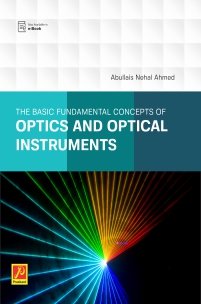The book “The Basic Fundamental Concepts of Optics and Optical Instruments” follows the CBCS pattern of Savitribai Phule Pune University’s (SPPU) under-graduate (B.Sc.) programme. It should also be noted that this book is written not only for students of SPPU but also all graduation students from all Indian Universities. It is extremely difficult for the teacher incharge to convey the principle and comprehensive process of derivation to each pupil due to significantly high strength in challenging theories. The author attempted to establish a setting that was as near to any conventional animation and laboratory environment as feasible while writing this book.
This book is written with the intention of addressing all the practical issues. If a student attentively examines the fundamental ideas before moving on to the more difficult ones, he or she will most likely just need a reasonable amount of time from the teacher.
1. Geometrical Optics
1.1 Introduction to Development of Optics
1.2 Types of Lenses
1.3 Converging & Diverging Lenses
1.4 Important Terms in Optics
1.5 Sign Convention
1.6 Thin & Thick Lenses
1.7 Lens Formula for Thin Lenses
1.8 Linear Magnification
1.9 Refraction at a Convex Surface
1.10 Lens Maker’s Formula
1.11 Cardinal Points of an Optical System
1.12 Focal Points & Focal Planes
1.13 Principal Points & Principal Planes in Thick Lens
1.14 Nodal Points & Nodal Planes
1.15 Deviation by a Thin Lens
1.16 Combination of Two Thin Lenses
1.17 Cardinal Points of Two Convex Lenses
2. Lens Aberrations
(A) Monochromatic (or Siedel) Aberrations
2.1 Spherical Aberration
2.2 Reductions of Spherical Aberration
2.3 COMA
2.4 Astigmatism
2.5 Reduction of Astigmatism
2.6 Curvature of the Field
2.7 Reduction in Curvature of the Field
2.8 Distortion
2.9 Reduction of Distortion
(B) Chromatic Aberrations
2.10 Longitudinal (or axial) Chromatic Aberration
2.11 Lateral Chromatic Aberration
2.12 Achromatism
2.13 Achromatism for two Lenses in Contact
2.14 Achromatism for two Lenses Separated by a Distance
3. Optical Instruments
3.1 Basic Definitions
3.2 Simple Microscope
3.3 Compound Microscope
3.4 Eye-Pieces
3.4.1 Ramsden’s Eye-Piece
3.4.2 Huygen’s Eye-Piece
3.4.3 Difference between Ramsden’s Eye-piece & Huygen’s Eye-piece
3.4.4 Gauss’s / Gaussian Eye-piece
3.5 Telescope
3.6 Angular Magnification of Telescope
3.7 Transmission Telescope
3.7.1 Refracting Astronomical Telescope
3.7.2 Entrance & Exit Pupils of an Astronomical Telescope
3.7.3 Astronomical Telescope with Final Image at Near Point
3.7.4 Terrestrial Telescope
3.7.5 Galilean Telescope
3.8 Reflecting Telescope
3.8.1 Newtonian Telescope
3.8.2 Gregory’s Telescope
3.8.3 Cassegrain’s Telescope
3.9 Comparison of Refracting & Reflecting Type Telescope
3.10 Constant Deviation Spectrometer
3.11 Basic Principle of Optical Camera
3.12 Resolving Power of an Optical Instruments
3.13 Resolving Power of an Astronomical Telescope
4. Interference
4.1 Introduction
4.2 Classification of Interference
4.3 Stoke’s Treatment
4.4 Interference in Thin Film
4.5 Interference Due to Reflected Light
4.6 Interference Due to Transmitted Light
4.7 Fringes of Equal Inclination
4.8 Interference by Wedge Shaped Film
4.9 Fringe Width
4.10 Fringes of Equal Thickness
4.11 Fringes of Equal Chromatic Order
4.12 Colours of Thin Films
4.13 Newton’s Ring
4.14 Applications of Newton’s Ring
4.15 Interferometry
4.16 Michelson Interferometer
4.16.1 Types of Fringes
4.16.2 Determination of Wavelength
4.16.3 Determination of the Difference in the Wavelength of two Wave
4.17 Fabry-Perot Interferometer
4.17.1 Formation of Fringes
4.17.2 Determination of the Difference in the Wavelength of two Waves
5. Diffraction
5.1 Introduction
5.2 Distinguish Between Fresnel’s Diffraction & Fraunhoffer’s Diffraction
5.3 Fraunhoffer’s Diffraction at a Single Slit
5.4 Fraunhoffer’s Diffraction at Double Slit
5.5 Plane Diffraction Grating
5.6 Rayleigh’s Criterion for Resolution
5.7 Resolving Power
5.8 Resolving Power of a Grating
5.9 Difference Between Interference & Diffraction
6. Polarization
6.1 Some Basic Terms
6.2 Concept of Polarization
6.3 Study of Polarization with Tourmaline Crystal Plate
6.4 Law of Malus
6.5 Polarization by Reflection
6.6 Brewster’s Law
6.7 Applications of Brewster’s Law
6.8 Polarization by Double Refraction
6.9 Anisotropic Crystal
6.10 Calcite Crystal
6.11 Huygen’s Explanation of Double Refraction
6.11.1 Negative Crystal
6.11.2 Positive Crystal
6.12 Similar Properties of O-ray & E-ray
6.13 Distinguish between Ordinary Rays and Extra-ordinary Rays
6.14 Nicol Prism
6.15 Types of Polarization
6.16 Linear Polarizer
6.16.1 Uses
You must be logged in to post a review.





































Reviews
There are no reviews yet.